ORIGINAL ARTICLE
RODRIGUES, Ana Caroline Santana [1], SANTOS, Helen Derlane Rabelo [2], LOBATO, Renan Gustavo Mota [3], DIAS, Claudio Alberto Gellis de Mattos [4], ALVES, Roberto Marcel Soares [5], DENDASCK, Carla Viana [6], ARAÚJO, Maria Helena Mendonça de [7], SILVA, Anderson Walter Costa [8], FECURY, Amanda Alves [9]
RODRIGUES, Ana Caroline Santana. et al. Comparative assessment of anxiety and depression levels in cancer patients and their companions in a highly complex oncology unit in Amapá. Revista Científica Multidisciplinar Núcleo do Conhecimento. Year. 07, Ed. 11, Vol. 03, pp. 87-106. November 2022. ISSN: 2448-0959, Access link: https://www.nucleodoconhecimento.com.br/health/anxiety-and-depression, DOI: 10.32749/nucleodoconhecimento.com.br/health/anxiety-and-depression
ABSTRACT
Cancer, due to its high lethality rate, generates negative feelings, which can modify family performance and cause great suffering. With this, it predisposes both the patient, caregivers and family members to the development of mental disorders. Of these, the most common are depression and anxiety. Based on the importance of the aforementioned scenario and the need to know the reality in the State of Amapá, the levels of anxiety and depression of outpatients and their companions at the High Complexity Oncology Unit of the State of Amapá were analyzed comparatively. Amapá, through a qualitative, descriptive and cross-sectional study, applying a sociodemographic questionnaire and the Hospital Anxiety and Depression Scale. After analysis, we found in this study a sociodemographic profile compatible with that expected for the State and similar to those of regions with a low level of socioeconomic development in the various variables analyzed. In addition, it was found in the present study that companions are possibly more depressed than anxious, a fact confirmed by statistical tests. This differs from the findings pointed out in other literature, in which anxiety is more reported than depression. Thus, it was concluded that in addition to strengthening public health policies, there is a need to strengthen a broad family approach, as well as the need for further studies aimed at elucidating the divergence found in the anxiety category.
Keywords: Cancer, Depression, Anxiety, Cancer Patients, Companions.
INTRODUCTION
Cancer is a disease that causes fear due to its high fatality rate (BASTOS, 2017). In addition, the oncological diagnosis can trigger changes in the family’s functional performance and in the perception of the end of life (FARINHA, 2013). In this way, it is a diagnosis that can change the thinking and way of life of the patient and his companions, who see him in a life-threatening situation, with difficulty in healing and, therefore, close to death (FERREIRA, 2016). In addition, it brings with it indignation and questions about the existence and physical and psychological disorders. Among the psychological disorders, depression and anxiety disorders stand out (LORRENCETTI, 2005).
According to the World Health Organization (WHO), depression is the most common disabling psychiatric disorder in the world. In this sense, the worldwide prevalence of depressive disorder is equivalent to 4.4%, whereas that of anxiety disorder is 3.6% and both are growing (WHO, 2017). Although these disorders can be present in anyone, the risk of depression increases when related to physical illnesses, characterizing them as comorbidities (WHO, 2017).
Cancer is characterized as a set of diseases that have in common disordered cell proliferation, the result of the continuous and expressive accumulation of errors and mutations in the DNA, causing failures in the mechanisms of control, growth and proliferation of the cell cycle (INCA, 2019 ; LOPES, 2013). Such cellular changes make them aggressive and uncontrollable, forming the tumor and spreading its cells, a stage called metastasis, which is the indicator of the severity of the disease (INCA, 2019).
In 2018, it was estimated that 9.6 million people died from cancer worldwide, with the Americas having 21.0% incidence and 14.4% mortality in the world (IARC, 2018). It is believed that these data are the result of the contemporary epidemiological transition, as well as the greater exposure of man to potentially mutating and carcinogenic environmental factors and the advancement of medicine in relation to the improvement of diagnosis and the reduction and control of historically lethal diseases. Cancers are considered the second single cause of death, second only to cardiovascular diseases. With this, it was predicted that, in 2020, cancers would constitute the first cause of death in Brazil (KATZ, 2013).
However, cancer is a chronic disease with a high cost and low accessibility to treatment (NOBREGA, LIMA, 2014), which, in addition to the emotional disorder, tends to increase the number of patients who seek the Unified Health System (SUS)[10]. Thus, in order to meet the principle of universality of the SUS (BRASIL, 1990), a High Complexity Assistance Unit (UNACON)[11] was created in the State of Amapá to provide physical and mental health assistance to cancer patients in the State and nearby ribeirinhas regions (BRASIL, 2017; CASTRO et al., 2022).
Furthermore, due to the increase in the number of cases of cancer and its comorbidities, together with a diagnosis that provokes emotional reactions related to a pessimistic perception and feeling about the future and imbalances and internal conflicts, it is believed that this disease can lead to psychic disorders ( THEOBALD, 2016).
Among these pathologies, according to Sadock (2017) and the V Manual Diagnóstico e Estatístico de Transtornos Mentais (translated into Portuguese from the original Diagnostic and Statistical Manual of Mental Disorders) DSM-5, depression, classified as a mood disorder, is three times greater in the elderly (over 60 years), the same age group that generally modulates the profile of cancer patients. In addition, stressful events, such as the cancer diagnosis, are triggers for depressive episodes.
Anxiety disorders, on the other hand, group a spectrum that involves fear, anxiety and related behavioral disorders, which can also develop after life stress (DSM-5, 2014; SADOCK, 2017). Thus, recognizing patients and their companions as individuals in need of assistance in the face of their anxieties can be important for improving attention and care in the various services offered by oncology centers, facilitating knowledge of how to act in the face of the disease.
Based on the above and in line with Ordinance No. 1,820, of August 13, 2009, which ensures patients the right to be accompanied during consultations, exams and hospitalization, this study arose from the need to identify and compare the levels of depression and anxiety of patients and their companions, aiming at a better understanding of these conditions and the possibility of providing subsidies for the development of strategies for the prevention and treatment of depression and anxiety for both patients and caregivers. Therefore, the objective was to identify and comparatively evaluate the levels of anxiety and depression of cancer patients and their companions at a UNACON in Amapá, correlating epidemiological data of these patients and their companions.
METHOD
This was a quantitative, descriptive and cross-sectional study. The quantitative focus of this research measured the data collected through forms and analyzed them using statistical methods (SAMPIERI, COLLADO, LUCIO, 2013). The descriptive study was concerned with describing associations between the studied variables (GIL, 2010), in this case, associated with anxiety and depression disorders related to the diagnosis of cancer. Finally, the cross-sectional aspect of this study referred to the moment of data collection without focusing, therefore, on possible oscillations in the information collected in the selected sample (HOCHMAN et al., 2005).
The research was carried out at the outpatient clinic of the High Complexity Assistance Unit (UNACON) located on the premises of the Hospital das Clínicas Dr. Alberto Lima (HCAL), headquartered in the city of Macapá-AP.
The population studied in this research was cancer patients and their respective companions, with the limit of one companion for each cancer patient participating in this study, treated in an outpatient service, in which both have voluntarily agreed to participate in the research by signing the Free and Informed Consent Form (TCLE)[12].
The population of cancer patients and their companions in this research was of both sexes, aged over 18, patients who had a confirmed diagnosis of malignant neoplasm, or in follow-up of up to 5 years after removal/regression of neoplastic foci or, even , in palliative care, all being treated at the UNACON Oncology Clinic and Oncology Surgery outpatient clinics. Patients and companions who did not meet the inclusion criteria, patients who were using drugs that interfere with their decision-making capacity, as well as cancer patients who did not identify and/or indicate a companion to participate in this research, and individuals who refused to sign the TCLE, or who were cognitively debilitated.
A total of 120 people participated in the research, excluding 40, in which one or both of the analyzed groups did not fit the inclusion criteria of this research.
The risks of this research included the individual and collective psychological variable of cancer patients, as well as their companions, since these are people vulnerable to emotional disorders (BRASIL, 2012). In order to mitigate such risks, it was available to take the case to medical-psychological discussion, which is routinely carried out at UNACON, or request psychiatric consultation, services provided for in Ordinance No. 458/17 (BOTEGA, 1995; BRASIL, 2017).
The individuals surveyed had potential benefits by identifying the explanation regarding their mental health condition and, indirectly, there was the identification of possible mental disorders linked to stress related to the pathology, the bonus to the general and scientific community about greater knowledge about the impacts of emotional disorders concomitant with the disease and treatment in cancer patients and their companions.
For data collection, cancer patients and their respective companions, who were in the waiting room of UNACON outpatient clinics, were invited to participate in the study. Therefore, the signature of the TCLE was explained and requested. This collection was carried out weekly in individual office rooms. The sociodemographic questionnaire was applied through an interview conducted by the researchers, as well as, in the specific case of cancer patients, the clinical questionnaire.
Subsequently, both cancer patients and their respective companions received the Hospital Anxiety and Depression Scale (HADS) and then completed it without intervention from the researchers, except in cases of illiterate patients. For respondents who are not literate, the questions were read aloud and good applicability of the HADS has already been demonstrated in respondents with a low level of education (BOTEGA et al., 1995).
However, it was ensured that the application of questionnaires was not long to avoid fatigue of the interviewees (LAKATOS, MARCONI, 2010), therefore, 15 minutes were allocated to each participant in this research.
For the tabulation of the collected data, a database was built and organized using Microsoft Excel 365, which was also used to obtain absolute and relative frequencies, mean and standard deviation (sd) calculations of the ages of the participants in this research, as well as for drawing up graphs and tables. To investigate the association between anxiety levels and depression levels with companion and patient categories, the chi-square (χ2) independence test was used. A significance level of p-value ≤ 0.05 was adopted. The software used was the Statistical Package for the Social Sciences® 20.0.
The research was submitted and approved by the Ethics Committee for Research with Human Beings (CAAE 27847920.6.0000.0003).
RESULTS
Thus, 40 patients and 40 companions were analyzed. Among the patients, 26 were female and 14 were male. Among the companions, 28 are female and 12 are male. Both categories demonstrate, therefore, a predominance of females.
The gender distribution, in both categories, is shown in graphs 1 and 2.
Graph 1. Number of patients assisted at UNACON-AP by gender
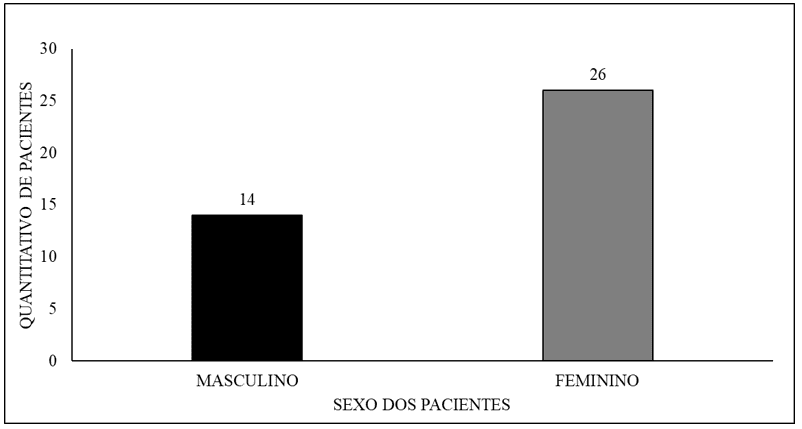
Graph 2. Quantitative of companions assisted at UNACON-AP by gender
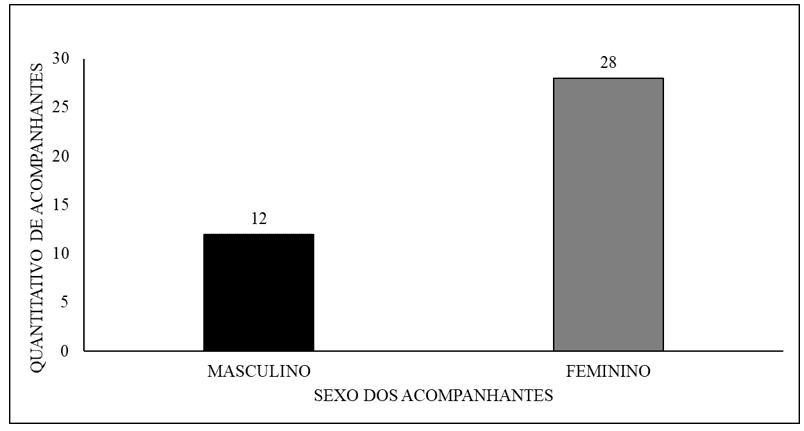
With regard to the age ranges and sex of the group of patients, there was a predominance of males (78.5%) at the most advanced ages, above 60 years; of patients and females (73%) aged up to 60 years in this same group (Graph 3).
Graph 3. Quantitative ratio of sex/age group of patients assisted at UNACON-AP
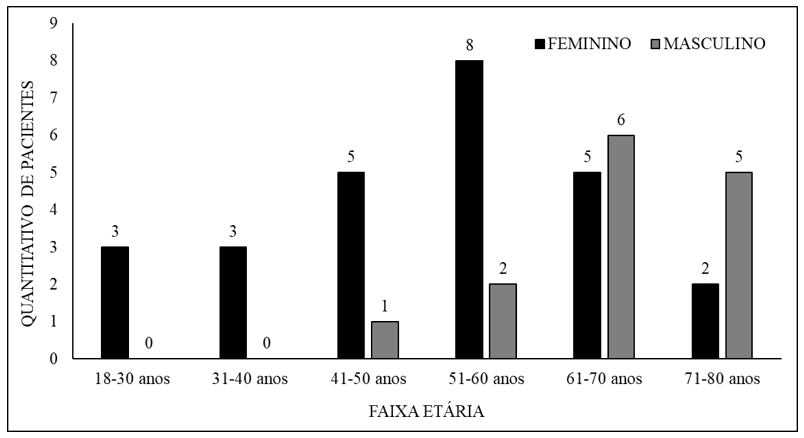
With regard to the age groups and sex of the group of companions, there was a predominance of females (42.8%) in the ages between 31 and 40 years, and in males there was partial balance at all ages (Graph 4).
Graph 4. Quantitative sex/age group ratio of companions assisted at UNACON-AP
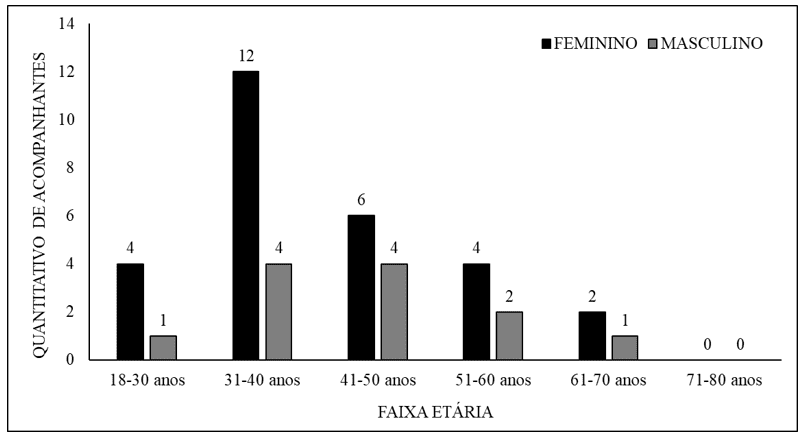
Observing the education of the two groups, it was noted the predominance of the lowest level of education (Elementary School I) or even the absence of this (Illiterate), in the group of patients (65%). While in the group of companions, there is a predominance of a higher level of education, with higher education prevailing (50%), of these eight participants (40%) signed Higher Education incomplete and twelve participants (60%) marked Higher Education Complete.
Graph 5. Relationship between the number of participants and the education of patients and caregivers treated at UNACON-AP
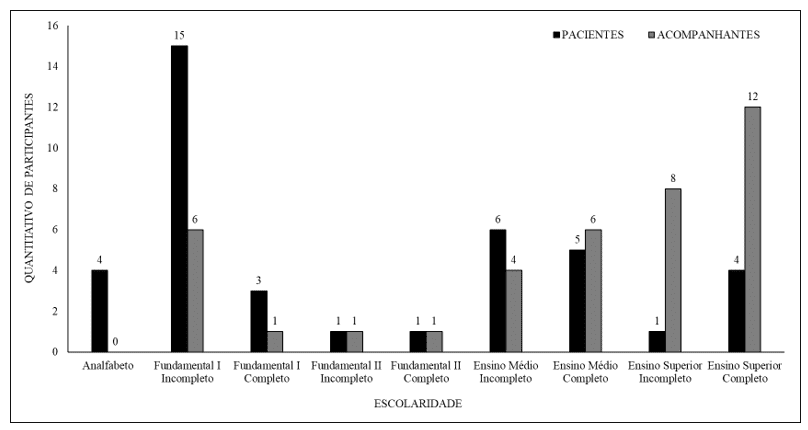
Regarding family income, the behavior of both categories was similar, with Class E (81.2%) being the most found correlating the groups.
Graph 6. Quantitative relationship of participants with family income of individuals assisted at UNACON-AP
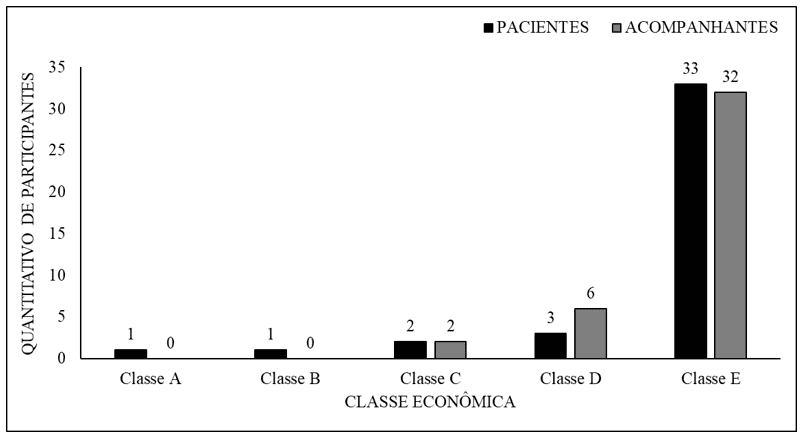
The types of CA most found in the patients evaluated in this study were cancers: cervix, breast, stomach and prostate (Graph 7). In women, the four most common types were cervical cancer, breast cancer, uterine cancer and ovarian cancer (Graph 8). In men, the two types reported in decreasing order of frequency were stomach cancer and prostate cancer (Graph 9).
Graph 7. Quantitative and distribution of types of cancer treated at UNACON-AP
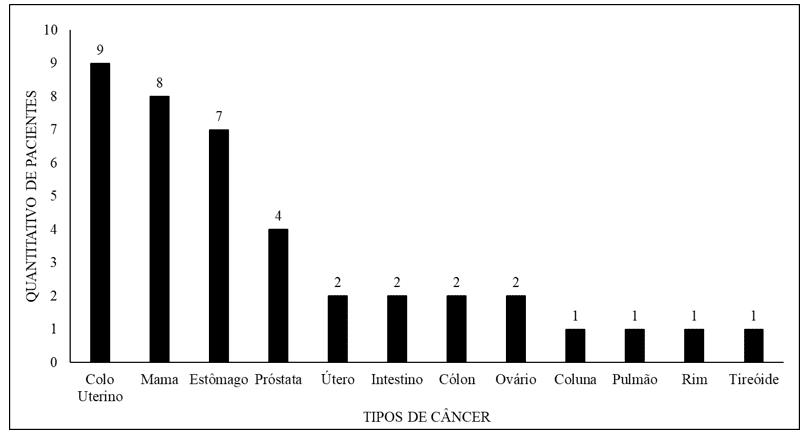
Graph 8. Quantitative and distribution of the most common types of cancer in female patients assisted at UNACON-AP
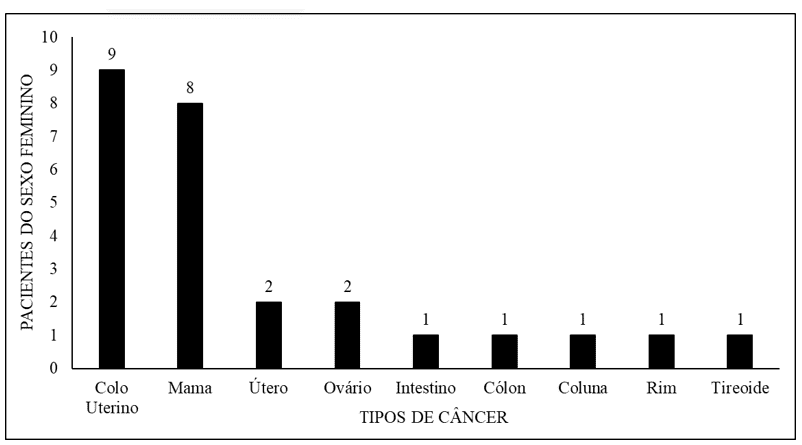
Graph 9. Quantitative and distribution of the most common types of cancer in male patients assisted at UNACON-AP
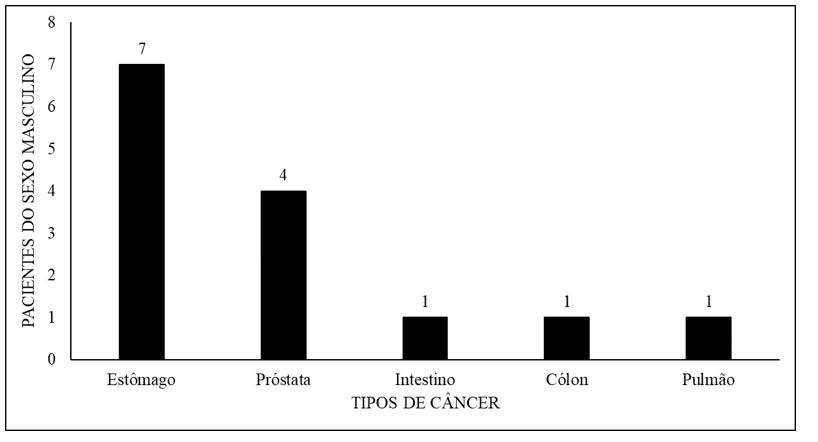
Analyzing the Hospital Anxiety and Depression Scale (HADS), it was observed that the results found were statistically different between patients and caregivers for depression (Table 1), but there was no statistically significant difference when assessing anxiety between the two groups (Table two). Thus, among the 80 study participants, 11 (13.75%) obtained scores referring to the level of probable depression. Of these 11 individuals, 9 (81.8%) were companions.
The χ2 independence test demonstrated a statistically significant association between higher levels on the depression scale (probable depression) and the category of hospital companion (χ2 = 7.67; p-value = 0.0229). The absolute and relative frequencies of the variables analyzed in the χ2 test are shown in Table 1.
Table 1. Statistics on the level of depression of individuals assisted at UNACON-AP
| Variable (n) | Level of depression | χ2 | p-value | ||
| Unlikely (%) | Questionable (%) | Likely (%) | |||
| Condition in hospital (n=80) | |||||
| Patient | 24 (49,0) | 14 (70,0) | 2 (18,2) | 7,67 | 0,0229 |
| Companions | 25 (51,0) | 6 (30,0) | 9 (81,8) | ||
χ2: Chi-square independence test. Source: Authors’ data.
In addition, among the 80 study participants, 10 (12.5%) obtained scores referring to the level of probable anxiety. Of these 10 individuals, 7 (70.0%) were companions. The χ2 independence test did not show a statistically significant association between higher levels on the anxiety scale (probable anxiety disorder) and the category of hospital companion (χ2 = 2.01; p-value = 0.3863). The absolute and relative frequencies of the variables analyzed in the χ2 test are shown in Table 2.
Table 2. Statistics on the level of anxiety of individuals assisted at UNACON-AP
| Variable (n) | Anxiety level | χ2 | p-value | ||
| Unlikely (%) | Questionable (%) | Likely (%) | |||
| Condition in hospital (n=80) | |||||
| Patient | 24 (51,1) | 13 (56,5) | 3 (30,0) | 2,01 | 0,3863 |
| Companions | 23 (48,9) | 10 (43,5) | 7 (70,0) | ||
χ2: Chi-square independence test. Source: Authors’ data.
DISCUSSION
Most of the patients who composed this study are female. A similar pattern was found in an article by Gonçalves et al. (2018), where this group represented more than half of the sample, a result attributed to the greater presence of women in the search for health services, providing a greater chance of early diagnoses. In contrast, the low male demand for the same services is possibly supported by a stereotyped idea that self-care is essentially female (CHAVES, 2018). This disparity found in this study and in the literature reflects the need to reinforce public policies aimed at promoting men’s health (CARNEIRO; ADJUTO; ALVES, 2019).
As for the gender of companions, trends similar to those found in the literature were observed in this study, with a higher frequency of women in this category (FALCÃO et al., 2020; POLONIO; DHEIN; PIVATTO, 2020). This finding corroborates the concept that the task of caring is charged and attributed to women, as a worldwide phenomenon, naturalized historically and in different cultures, despite the countless other responsibilities they may assume (LEBREGO; LOBATO; FIMA, 2018; FAGUNDES , SOARES, 2018).
Regarding the age ranges and gender of the patients, there was a predominance of males aged over 60 years and females below this cutoff point. This relationship can be explained by the high frequency of cervical cancer found in the sample, which tends to affect younger women and who start sexual activities early (INCA, 2022a; IBGE, 2019) as opposed to stomach cancer and prostate, whose incidences are higher in elderly men, and may be related to H. pylori infection, dietary factors (such as consumption of high-sodium foods and processed meats) and lifestyle habits (such as smoking and alcoholism) (INCA, 2022b; BESAGIO, 2021). Thus, it is possible to infer that this result is expected, considering the natural history of the aforementioned neoplasms.
Most companions who participated in this study are aged between 31 and 50 years, a predominant age group for both sexes. Similar results were found in studies by Kilic and Oz (2019), where most family caregivers (50.3%) were concentrated in the same age range, and also in Oliveira and Sousa (2017), whose average age found was 43.47. A likely hypothesis to explain this trend would be that most companions are the patients’ children, as found in a study by Falcão et al. (2020). However, this cannot be said, considering that in this work the degree of kinship was not questioned. Another hypothesis would be that in this age group are retired or unemployed people, having more time for the task of caring (NARDI et al., 2011).
With regard to education, an antagonism was observed in this research between the groups of patients and caregivers. Thus, it is worth noting that the universalization of access to basic education in the country occurred with the promotion of financing cooperation between the three spheres of the Executive Branch through the National Fund for Fundamental Education (FUNDEF)[13] in the mid-1990s (FERREIRA , POMPONET, 2020). A possible explanation for this difference can be inferred from the correlation between the average ages of the analyzed groups, which is higher in the group of patients (55.62) against (40.65) of companions.
In addition to the aforementioned, at the beginning of the 21st century, the Fund for the Maintenance and Development of Basic Education (FUNDEB) was established, linking the cost of education to the Gross Domestic Product (GDP) of the country, through Constitutional Amendment 59, in addition to establishing several programs that aimed to: increase the number of vacancies in Higher Education, expand and internalize the Federal Institutes of Higher Education (IFES)[14], finance the access of the low-income population to Private Higher Education, in addition to the institution of quota policies (BRASIL, 2014; CARNEIRO, BRIDI, 2020; CURY, 2018; MUSSLINER et al., 2021; TREVISOL, MAZZIONI, 2018). Thus, possibly the higher level of education of companions may have been due to the greater opportunity to access education resulting from educational reforms and government programs created after the re-democratization of Brazil.
Regarding family income, the lowest of them, Class E, was the most found among the participants. According to Júlio and Hemais (2019), the economic crises faced by Brazil tend to favor the loss of access to health services provided by private individuals by the poorest population. In addition, according to Fiocruz (2018), the decrease in financial investments in health that occurred in the country may imply a reduction in access to health services by this class. Thus, this population is usually dependent only on SUS, and perhaps because of this, it is the class that most seeks UNACON-AP services.
Souza (2019) states that the population with the highest purchasing power tends to seek private care, having the greatest access to health care. Furthermore, the IBGE (2018) shows that high-complexity services are costly and depend on average displacements of 276 km, departing from the North Region. These facts suggest the expenditure of high financial resources, which, generally, the E class does not have.
The types of Cancer most found in the sample of this study were those of the cervix, breast, stomach and prostate, in decreasing order of frequency. The data differ when compared to the estimated incidence of INCA (2019) for 2020 predicted for the North Region and for the State of Amapá, as in both, prostate cancer would be the most frequent. This finding can be explained by the lower proportion of male patients compared to female patients who participated in this study.
In the female population, neoplasms of the uterine cervix and breast are the most frequent, respectively, in this study. Similar to the estimated incidence positions for the North region and different from the other regions of Brazil, where breast cancer ranks first (INCA, 2019). This predominance of cervical cancer can be attributed to the low level of development in the North region in relation to other regions of the country (LOUREIRO, 2019), as well as to the early onset of sexual activity (average age of 15.9 for the State do Amapá, the smallest in the country) (IBGE, 2019), which constitutes an important risk factor for the aforementioned neoplasm.
In relation to male patients, there was a predominance of stomach and prostate cancers, in this order, which is reversed when compared to the estimated incidence for the North Region and for the State of Amapá (INCA, 2022). This relationship differs from a study by Tavares et al. (2020), carried out in the same location as the present study, where, based on the analysis of 320 medical records, a higher frequency of prostate cancer was found in male patients. It is possible to infer, therefore, taking into account the comparison of the number of patients in the two studies, that the present study probably brought a less reliable selection of the types of neoplasia in the male population in question.
Regarding anxiety levels, the results found were similar between patients and caregivers, however there was divergence between the two categories when assessing the depression scale. Thus, the anxiety category was similar and without statistical significance between patients and caregivers. In this sense, comparing the study by Ferreira (2016), it was observed that the results of the present study differ, as the depression category in patients is higher, and, according to Cordeiro et al. (2021), anxiety affects a greater number of companions than patients. Such divergence may be a result of the small sample analyzed in the present study; with a larger sample, possibly the results would be similar to other studies.
On the other hand, it is observed that, among the participants with results referring to probable depression, the companion category showed higher levels of depression and showed significant statistics. Rodrigues (2020) and Cordeiro (2021) demonstrated that depression, unlike what was found in this study, is less prevalent in companions, as fear and anguish become greater in companions than sadness.
However, Bernardes et al. (2019) and Monteiro et al. (2018) reported that both the level of anxiety and depression are higher in caregivers whose respective patients have lowered mood. In addition, companions tend to have symptoms of depressed mood. In this way, it is possible that companions have more significant degrees of depression because they have to make decisions in the face of the disease, monitor the patient’s finitude and become the person responsible for the patient, feeling overwhelmed and dismayed in the face of this function.
CONCLUSION
Cancer is a disease of great importance today, bringing significant impacts on the quality of life of patients and those accompanying them in the course of treatment of this disease. In this sense, it is essential to know the repercussions that this pathology entails in the context of the individuality of each patient and also the recognition of the peculiarities with which it presents itself in each region so that, in this way, the most appropriate strategies of confrontation.
In our study, we found results similar to those expected for the region in terms of the studied variables (gender, age group, income, most frequent cancers), with due reservations made, following a trend comparable to countries with low socioeconomic development. Thus, there is a need to reinforce public policies aimed mainly at men’s health, in their earlier access to health services, as well as women’s access to cervical cancer screening programs, taking into account for timely detection and treatment when needed.
When comparing the patient and companion categories, we found that companions had higher levels of education, supposedly due to their greater access to education, as a result of educational reforms and government programs created after Brazil’s re-democratization. In addition, there was an absolute predominance of class E participants in our sample, correlated with greater dependence on the SUS.
Finally, when the HADS was applied, there was statistical significance between the groups evaluated for the depression category, but not for anxiety, demonstrating higher levels of depression among companions when compared to patients. Such results differed from the analyzed literature, being possible hypotheses, the overload of responsibility on those who accompany the UNACON-AP patient in relation to the other studied populations or the small sample size, demonstrating the need for more robust future studies to elucidate the situation.
REFERENCES
BARBOSA, M. Democratização ou massificação do Ensino Superior no Brasil? Revista de Educação PUC-Campinas, v. 24, n. 2, p. 240-253, 2019.
BARROS, A. M. M. TELES, W. de S. SILVA, M. C. da. JÚNIOR, P. C. C. S. CALASANS, T. A. S. RODRIGUES, S.M. da S.S. SILVA, M. H. S. HORA, A. B. SANTOS, L. X. C. TORRES, R. C. Perfil epidemiológico dos casos de câncer do colo uterino no estado de Sergipe. Revista Eletrônica Acervo Saúde, v. 15, n. 4, p. e10043-e10043, 2022.
BERNARDES J, NOLASCO F, JARDIM A, CUNHA G, TAKESHITA I, BARROSO R. O acompanhante do paciente oncológico em fase terminal: percepção do técnico de enfermagem. Avances en Enfermería, 2019.
BRASIL. MINISTÉRIO DA EDUCAÇÃO. A democratização e expansão da educação superior no país 2003 – 2014.
BRASIL. Elza Berger Salema Coelho, Eduardo Schwarz,Carolina Carvalho Bolsoni, Thays Berger Conceição. Política nacional de atenção integral a saúde do homem. Florianópolis : Universidade Federal de Santa Catarina, 2018.
CARNEIRO, L. BRIDI, F. Políticas Públicas de Ensino Superior no Brasil: um olhar sobre o acesso e a inclusão social. Revista Ibero-Americana de Estudos em Educação, p. 146-158, 2020.
CARNEIRO, V. S. M; ADJUTO, R. N. P.; ALVES, K. A. P. Saúde do homem: identificação e análise dos fatores relacionados à procura, ou não, dos serviços de atenção primária. Arquivos de Ciências da Saúde da UNIPAR, v. 23, n. 1, p. 35-40, 2019.
CASTRO, E.P.A., REBOUÇAS, I.A., RODRIGUES, R.J.V., LUCENA, L.S., RODRIGUES, A.C.S., SANTOS, H.D.R., LOBATO, R.G.M., ALVES, R.M.S., DIAS, C.A.G.M., DENDASCK, C.V., FECURY, A.A. Doença Oncológica Em Pacientes Da Unidade De Alta Complexidade De Oncologia (Unacon) Do Amapá, Amazônia, Brasil, Entre 2019 E 2022. Revista Científica Multidisciplinar Núcleo do Conhecimento. Ano. 07, Ed. 11, Vol. 02, pp. 207-217. 2022
CORDEIRO, L. SANTOS, D. ORLANDI, F. Qualidade de vida, ansiedade e depressão em pacientes oncológicos em quimioterapia e familiares. Enfermagem em Foco, 2021
CURY, C. Financiamento da Educação Brasileira: do subsídio literário ao FUNDEB. Educação & Realidade, v. 43, n. 4, p. 1217-1252, 2018.
FALCÃO, V. M., SANTOS, S. P. M de M. BARBOSA, M. G. A., SILVA, M. M da. LINS, S. R. de O. Perfil da assistência de enfermagem prestada a pacientes oncológicos, na percepção dos acompanhantes. Brazilian Journal of Development, v. 6, n. 7, p. 54073-54084, 2020.
FAVARO C. R. P, DURANT, L. C. PATERRA, T. da S. V. PANOBIANCO, M. S. Gozzo, T. de O.Perfil epidemiológico de mulheres com câncer de colo do útero tratadas em hospital terciário. Revista de Enfermagem do Centro Oeste Mineiro. 2019.
FERREIRA, AS. BICALHO, BP. NEVES, LFG. MENEZES, MT. SILVA, TA. FAIER, TA. MACHADO, RM. Prevalência de Ansiedade e Depressão em Pacientes Oncológicos e Identificação de Variáveis Predisponentes. Revista Brasileira de Cancerologia, 2016.
FERREIRA, M. POMPONET, A. Escolaridade e trabalho: juventude e desigualdades. 2020.
FIOCRUZ. Schramm, Joyce Mendes de Andrade. Políticas de austeridade e seus impactos na saúde: um debate em tempos de crise – Rio de Janeiro, RJ: Centro de Estudos Estratégicos da Fiocruz / Fiocruz, 2018.
GENG, H. M., CHUANG, D. M., YANG, F., YANG, Y., LIU, W. M., LIU, L. H. TIAN, H. M. Prevalence and determinants of depression in caregivers of cancer patients: A systematic review and meta-analysis. Medicine, v. 97, n. 39, 2018.
GONÇALVES M.M. GUEDES, N.A.B. MATOS, S.S. TIENSOLI, S. SIMINO, P. R. CORRÊA, A. dos R. Perfil dos Atendimentos a Pacientes Oncológicos em uma Unidade de Pronto Atendimento. Revista de Enfermagem do Centro-Oeste Mineiro. 2018.
IBGE. INSTITUTO BRASILEIRO DE GEOGRAFIA E ESTATÍSTICA. Pesquisa Nacional de Saúde. Tabela 8001: Idade média de iniciação da atividade sexual das pessoas de 18 anos ou mais de idade, por sexo e situação do domicílio. IBGE, 2022. Disponível em: https://sidra.ibge.gov.br/tabela/8001#resultado. Acesso em: 05 de maio 2022
IBGE. Regiões de influência das cidades: 2018 / IBGE, Coordenação de Geografia. – Rio de Janeiro: IBGE, 2020.
INCA. INSTITUTO NACIONAL DE CÂNCER JOSÉ ALENCAR GOMES DA SILVA. Estimativa 2020: incidência de câncer no Brasil. Ministério da Saúde. INCA, Rio de Janeiro, 2019.
INCA. INSTITUTO NACIONAL DE CÂNCER JOSÉ ALENCAR GOMES DA SILVA. Tipos de câncer: Câncer do colo do útero. Disponível em: https://www.inca.gov.br/tipos-de-cancer/cancer-do-colo-do-utero/profissional-de-saude. Acessado em: 5 de maio de 2022a.
INCA. INSTITUTO NACIONAL DE CÂNCER JOSÉ ALENCAR GOMES DA SILVA. Tipos de câncer: Câncer de próstata. Disponível em: https://www.inca.gov.br/tipos-de-cancer/cancer-de-prostata. Acessado em: 5 de maio de 2022b.
IARC. International Agency for Research on Cancer. Latest global cancer data: Cancer burden rises to 18.1 million new cases and 9.6 million câncer deaths in 2018. GLOBOCAN 2018. Press release n° 263. Disponível em http://gco.iarc.fr/. Acessado em 10/05/2019.
JÚLIO, Luiz Felipe Feltrim. HEMAIS, Marcus Wilcox. Significados de Planos de Saúde para Consumidores de Baixa Renda. Revista Pretexto. Vol. 20, N. 4. Belo Horizonte, 2019.
KILIC, S. T.; OZ, F. Family caregivers’ involvement in caring with cancer and their quality of life. Asian Pacific Journal of Cancer Prevention: APJCP, v. 20, n. 6, p. 1735, 2019.
LEBREGO, A. M.; LOBATO, S. M. C. FIMA, L. R. V. O Papel de Cuidadora Atribuído à Mulher: escuta psicológica de acompanhantes de pacientes em tratamento hemodialítico. Gênero na Amazônia, n. 14,2018.
LOUREIRO, Dielle de Carvalho et al. Perfil epidemiológico dos principais tumores sólidos em uma unidade de alta complexidade em oncologia no estado da Amazônia legal. Rev. bras. ciênc. saúde, p. 273-286, 2019.
MONTEIRO, C. SCHOUERI, J. CAMARGO, C. SATO, L. MONTEIRO, Y. PASSARELA, K. SHIMAOKA, G. OLIVEIRA, R. ARGANI, I. SETTE, C. CUBERO, D. GIGLIO, A. Avaliação de qualidade de vida e depressão em pacientes oncológicos e em seus cuidadores e o acesso dos pacientes a reabilitação. Clinical Oncology Letters, 2018.
MUSSLINER, B. MUSSLINER, M. MEZA, E. RODRIGUES, G. O problema da evasão universitária: um desafio à democratização do ensino superior público. Brazilian Journal of Development, v. 7, n. 4, p. 42738-42758, 2021.
NARDI., T de., RIGO, J. C., BRITO, M. D., SANTOS, E. L. M. D., BÓS, Â. J. G. (2011). Sobrecarga e percepção de qualidade de vida em cuidadores de idosos do Núcleo de Atendimento à Terceira Idade do Exército (Natiex). Revista Brasileira de Geriatria e Gerontologia, 14, 511-519.
OLIVEIRA, T. R. SOUZA, J. R. Avaliação do impacto psicossocial do diagnóstico e tratamento do câncer na vida de familiares cuidadores de pacientes em regime de internação hospitalar. Tempus: Actas de saúde coletiva, Brasília, v. 11, n. 1, p. 215-227, 2017.
POLONIO, D. F.; DHEIN, G.; PIVATTO, C. Acompanhante do paciente com câncer no espaço hospitalar: sentidos atribuídos a sua função. Revista Thema, [S. l.], v. 17, n. 2, p. 318–335, 2020
RODRIGUES, Priscila de Freitas Richter. Avaliação dos índices de ansiedade, depressão e sobrecarga em familiares de pacientes de uma UTI oncológica. Dissertação de Mestrado. Fundação Antônio Prudente. Curso de Pós-Graduação em Ciências – Área de concentração: Oncologia. São Paulo, 2020.
SOUZA, Arthur Vasconcelos de. Desigualdades relacionadas à renda dos estilos de vida da população brasileira: uma análise com base na Pesquisa Nacional de Saúde 2013. 2019. 66 f. Dissertação (Mestrado em Economia Aplicada) – Faculdade de Economia, Administração e Contabilidade, Programa de Pós-graduação em Economia, Universidade Federal de Alagoas, Maceió, 2019.
TAVARES, M.V. de A. PICANÇO, M. S. PÁDUA, L. G. F. PENA, F. P da S. MELO, W. de S. Doença Oncológica: Perfil Epidemiológico em Unidade de Referência na Amazônia. Enfermagem em Foco, v. 11, n.3, p.169-177, 2020.
TREVISOL, Joviles Vitório; MAZZIONI, Lizeu. A universalização da Educação Básica no Brasil: um longo caminho. Roteiro, v. 43, n. 3, p. 13-46, 2018.
APPENDIX – FOOTNOTE
10. Sistema Único de Saúde (SUS).
11. Unidade de Assistência de Alta Complexidade (UNACON).
12. Termo de Consentimento Livre e Esclarecido (TCLE).
13. Fundo Nacional da Educação Fundamental (FUNDEF).
14. Institutos Federais de Ensino Superior (IFES).
[1] Medical Student at the Universidade Federal do Amapá (UNIFAP).
[2] Medical Student at the Universidade Federal do Amapá (UNIFAP).
[3] Medical Student at the Universidade Federal do Amapá (UNIFAP).
[4] Biologist, PhD in Theory and Research of Behavior, Professor and researcher at the Instituto de Ensino Básico, Técnico e Tecnológico do Amapá (IFAP), the Programa de Pós Graduação em Educação Profissional e Tecnológica (PROFEPT IFAP) and the Programa de Pós Graduação em Biodiversidade e Biotecnologia da Rede BIONORTE (PPG-BIONORTE), Amapá pole.
[5] Physician, Professor and researcher at the Medical Course at the Universidade Federal do Amapá (UNIFAP).
[6] PhD in Psychology and Clinical Psychoanalysis. Doctorate in progress in Communication and Semiotics at the Pontifícia Universidade Católica de São Paulo (PUC/SP). Master’s Degree in Religious Sciences from Universidade Presbiteriana Mackenzie. Master in Clinical Psychoanalysis. Degree in Biological Sciences. Degree in Theology. He has been working with Scientific Methodology (Research Method) for more than 15 years in Scientific Production Guidance for Master’s and Doctoral Students. Specialist in Market Research and Health Research. ORCID: 0000-0003-2952-4337.
[7] Physician, Professor and researcher at the Medical Course at the Universidade Federal do Amapá (UNIFAP).
[8] Physician, Professor and researcher at the Campus Macapá Medicine Course, Universidade Federal do Amapá (UNIFAP).
[9] Biomedical, PhD in Tropical Diseases, Professor and researcher at the Campus Macapá Medicine Course, Universidade Federal do Amapá (UNIFAP), and at the Programa de Pós-graduação em Ciências da Saúde (PPGCS UNIFAP), Pro-Rector of Research and Postgraduate Graduation (PROPESPG) from the Universidade Federal do Amapá (UNIFAP).
Submitted: November, 2022.
Approved: November, 2022.















